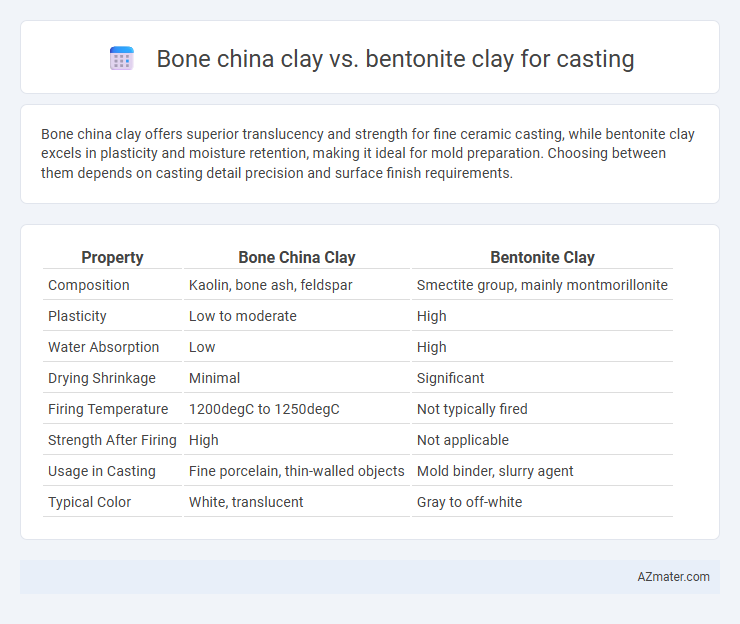Bone china clay offers superior translucency and strength for fine ceramic casting, while bentonite clay excels in plasticity and moisture retention, making it ideal for mold preparation. Choosing between them depends on casting detail precision and surface finish requirements.
Table of Comparison
| Property | Bone China Clay | Bentonite Clay |
|---|---|---|
| Composition | Kaolin, bone ash, feldspar | Smectite group, mainly montmorillonite |
| Plasticity | Low to moderate | High |
| Water Absorption | Low | High |
| Drying Shrinkage | Minimal | Significant |
| Firing Temperature | 1200degC to 1250degC | Not typically fired |
| Strength After Firing | High | Not applicable |
| Usage in Casting | Fine porcelain, thin-walled objects | Mold binder, slurry agent |
| Typical Color | White, translucent | Gray to off-white |
Introduction to Bone China Clay and Bentonite Clay
Bone china clay, a refined kaolin mixed with bone ash, offers exceptional whiteness and translucency, making it ideal for fine porcelain casting. Bentonite clay, composed mainly of montmorillonite, excels in its high plasticity and binding properties, providing flexibility and strength during the casting process. Both clays serve distinct roles: bone china enhances aesthetics and translucency, while bentonite improves workability and structural integrity in ceramic casting.
Composition and Mineral Content Comparison
Bone china clay primarily contains kaolin, feldspar, and bone ash, providing high whiteness and translucency, while bentonite clay is rich in montmorillonite, a smectite group mineral known for its exceptional swelling and binding properties. The calcium content in bone china clay contributes to its strength and vitrification during firing, whereas bentonite's high silica and alumina content enhance plasticity and water absorption for casting molds. Understanding these compositional differences is essential for selecting the appropriate clay based on required physical properties and casting techniques.
Physical Properties for Casting Applications
Bone china clay exhibits high plasticity and fine particle size, enabling smooth, detailed casting surfaces with minimal shrinkage; its purity ensures consistent texture and strength suitable for delicate molds. Bentonite clay features excellent water absorption and swelling capacity, providing superior mold flexibility and durability, but may cause increased shrinkage and longer drying times. The physical differences in plasticity, particle size, and shrinkage behavior significantly impact mold precision and casting quality in ceramic production.
Workability and Plasticity Differences
Bone china clay offers superior plasticity and workability for casting due to its fine particle size and kaolin-rich composition, allowing for smoother shaping and finer detail retention. Bentonite clay, known for its high swelling capacity and strong binding properties, displays less plasticity but provides excellent green strength, reducing shrinkage and cracking during drying. Choosing between bone china and bentonite clay depends on the desired balance between intricate detail and structural stability in casting projects.
Firing Temperature and Shrinkage Rates
Bone china clay typically fires at a higher temperature range of around 1200-1250degC, resulting in lower shrinkage rates of about 6-8%, which ensures dimensional stability in casting applications. Bentonite clay vitrifies at lower temperatures, generally between 900-1100degC, but exhibits higher shrinkage rates, often exceeding 10%, which can lead to warping or cracking during firing. Selecting bone china clay is preferable for projects demanding precision and minimal deformation under high-temperature firing conditions.
Surface Finish and Porosity Outcomes
Bone china clay offers a smoother surface finish with lower porosity, making it ideal for fine detail and polished ceramics in casting applications. Bentonite clay, known for its high plasticity and strong binding properties, tends to produce a more porous surface that requires additional treatment for achieving similar smoothness. The choice between bone china clay and bentonite clay directly influences the durability and aesthetic quality of the final cast product, with bone china favored for delicate, high-quality finishes.
Strength and Durability in Cast Pieces
Bone china clay exhibits superior strength and durability in cast pieces due to its high kaolin content and vitrification properties, resulting in a more robust and less porous final product. Bentonite clay, while excellent for plasticity and mold-making, lacks the structural integrity needed for durable castings, making it prone to cracking and weaker under stress. For applications demanding long-lasting and resilient castings, bone china clay is the preferred choice over bentonite clay.
Cost and Availability for Casters
Bone china clay is more expensive and less readily available compared to bentonite clay, making it a less economical choice for casters on a budget. Bentonite clay offers wider availability and lower costs due to its natural abundance and simpler processing. Casters seeking affordable and accessible materials typically prefer bentonite clay for efficient mold casting.
Environmental Impact and Sustainability
Bone china clay, primarily composed of kaolin and feldspar, has a lower environmental impact due to its mineral-based composition and minimal chemical additives, making it more sustainable for casting processes. Bentonite clay, known for its superior plasticity and binding properties, often requires energy-intensive extraction and processing, which can contribute to habitat disruption and higher carbon footprints. Selecting bone china clay supports more environmentally friendly casting practices by reducing resource depletion and promoting recyclability in mold materials.
Choosing the Right Clay for Your Casting Needs
Bone china clay offers a smooth texture and fine particle size, making it ideal for detailed and delicate casting projects requiring high strength and translucency. Bentonite clay provides excellent plasticity and shrinkage control, preferred for molds and slip casting where flexibility and moisture retention are crucial. Selecting the right clay depends on whether the casting demands precision and durability (bone china clay) or moldability and workability (bentonite clay).

Infographic: Bone china clay vs Bentonite clay for Casting
 azmater.com
azmater.com